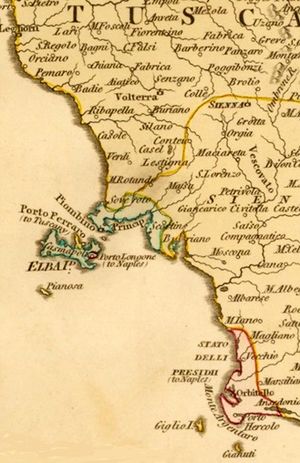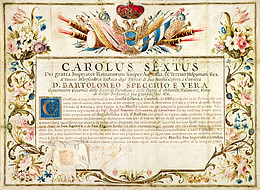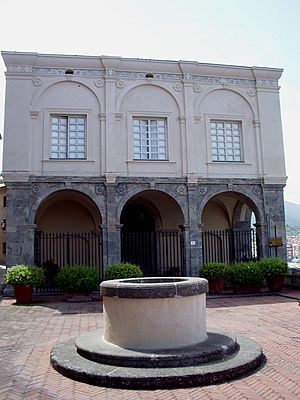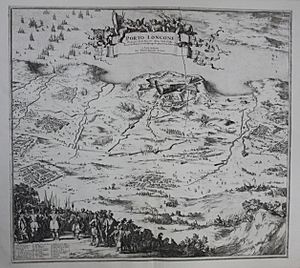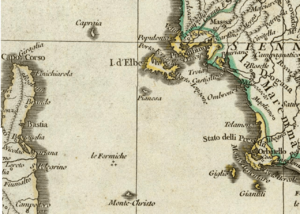State of the Presidi facts for kids
The State of the Presidi (which means "state of the garrisons") was a small area on the coast of Tuscany, Italy. It existed from 1557 to 1801. This territory included parts of the old Republic of Siena. It had five towns: Porto Ercole, Porto Santo Stefano, Orbetello, Talamone, and Ansedonia. It also included the small island of Giannutri and a fortress called Porto Longone on the island of Elba.
The Presidi covered about 300 square kilometers (about 115 square miles). It was closely connected to the Kingdom of Naples and changed rulers several times. This led to three main historical periods. From 1557 to 1707, it was owned by Spain. From 1708 to 1733, it was controlled by the Austrian Habsburgs. Finally, from 1733 to 1801, it was part of the Spanish Bourbon kingdom of Naples.
In 1801, the king of Naples gave the Presidi to the French Republic. The French then gave it to the new Kingdom of Etruria. After France's power ended in 1814, and after the Congress of Vienna in 1815, the Presidi territories became part of the Grand Duchy of Tuscany again.
Contents
How the Presidi Began
The Presidi were originally important coastal areas of the Republic of Siena. Spain kept these areas after the Duchy of Florence conquered Siena. Duke Cosimo I de' Medici took over Siena in 1555 during the last Italian War. Cosimo had help from Emperor Charles V, who was also King of Spain, and his son, Philip II, who was king of Naples.
In 1557, Philip II signed a treaty. Siena and most of its lands were given to Cosimo. However, certain coastal fortresses were specifically kept out of this deal. These included Porto Ercole, Orbetello, Talamone, Monte Argentario, and Porto Santo Stefano. This area was about 287 square kilometers (110 square miles). In 1558, the Spanish took Talamone by force from the French.
History of the Presidi
Spanish Rule (1557–1708)
Controlling the Presidi allowed Spain to watch ships traveling between Genoa (a Spanish ally) and Naples. In the 16th century, ships usually stayed close to the coast. The Presidi also served as a stop on the "path of Flanders" (Cammino di Fiandra). This was a route for Spanish soldiers moving from Naples to the Spanish Netherlands to fight rebels or the French. Soldiers would stop in the Presidi for supplies before continuing their journey.
In 1587, the Duke of Tuscany, Francesco, offered Philip II a lot of money for one of the Presidi towns. But the king of Spain refused. He said he had no other ports between Catalonia and Naples.
The Presidi also provided winter grazing land for Tuscan shepherds' sheep. In 1603, King Philip III decided to build a fortress on Elba. Construction of Fort San Giacomo at Porto Longone began in 1605. It could house 2,000 soldiers. This was the only time the Presidi expanded its territory.
In 1646, Orbetello successfully defended itself against a French attack. The French wanted to remove the Spanish from Italy. In June, the Spanish won a naval battle against the French near Porto Ercole. Later that year, the French captured Porto Longone. The Spanish soldiers there, only 80 men, held out for two weeks.
The Spanish recaptured both Piombino and Porto Longone in 1650. Porto Longone, with 1,500 French soldiers, held out for ten weeks. To protect against future attacks and pirates, Spain built another fortress called Fort Focardo. Naples kept the fortresses fully staffed, even during wars. In 1677, 300 men were sent to strengthen the Porto Longone fortress.
In 1678, Cosimo III of Tuscany tried to buy the Presidi. He wanted to exchange Orbetello for Portoferraio, which was often used by French privateers. In 1695, the Republic of Genoa also offered to buy the Presidi. The Spanish king Charles II refused both offers.
Austrian Rule (1708–1733)
During the War of the Spanish Succession, Emperor Charles VI claimed the Presidi. Between 1708 and 1712, he conquered all of them except Porto Longone. In 1714, France recognized Charles's claim.
In 1718, several European powers formed the Quadruple Alliance against Spain. They suggested that Don Carlos, the future Charles III of Spain, would receive the Grand Duchy of Tuscany and Porto Longone when the ruling House of Medici family died out. This happened as expected.
A peace treaty was signed in Vienna in 1725. In this treaty, Charles agreed that Don Carlos would receive the Duchy of Parma and Piacenza. The emperor would keep the coastal Presidi, and Spain would keep its rights in Piombino and Elba, including Porto Longone.
Bourbon Rule (1733–1801)
This situation changed in 1733 with the Treaty of Turin. France and Sardinia allied against the Holy Roman Empire. They agreed that Don Carlos should receive the Presidi along with the kingdoms of Naples and Sicily. Spain joined this alliance.
During the War of the Polish Succession in 1735, a Spanish army conquered the Presidi and the southern Italian kingdoms. A peace treaty in Vienna confirmed these conquests for Don Carlos. In 1736, the emperor officially gave the Presidi to him. This was finalized in the Peace of Vienna in 1738.
On March 21, 1801, France and Spain agreed to create the Kingdom of Etruria from the old Grand Duchy of Tuscany. They also agreed to give it the Principality of Piombino. France would take the Tuscan part of Elba (Portoferraio). On March 28, 1801, King Ferdinand IV of Naples agreed to give the State of the Presidi to France. He also gave up his rights on Elba (Porto Longone) and his claim over Piombino. These territories were then added to Tuscany to form the new Kingdom of Etruria.
On May 2, 1801, the French tried to take the Tuscan half of Elba. But the Tuscan soldiers, with British help, resisted. The Treaty of Amiens in 1802 forced the British to leave. The Presidi were formally given to Etruria on September 19, 1801. After this, their fate was tied to the rest of Tuscany. However, Piombino and Elba remained under French control.
How the Presidi Were Governed
Under Spanish rule, the treasury of Naples paid for the Presidi. They rotated soldiers and sent more troops when there was danger. Normally, five companies of infantry (foot soldiers) were stationed there. This was a large number, showing how important the Presidi were to Spain's defense plans, especially against France.
The highest civilian leader in the Presidi was the auditor (auditore). He was chosen by the viceroy and was in charge of justice. An inspector (veditore) managed the money for fortress repairs and soldiers' wages. He also oversaw supplies and artillery. The inspector had help from a comptroller and a payer. A harbourmaster (mastro portolano) was in charge of the ports and collecting taxes on goods. However, he was not always present in Orbetello.
See also
 In Spanish: Presidios de Toscana para niños
In Spanish: Presidios de Toscana para niños


